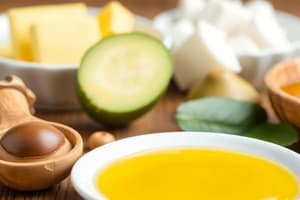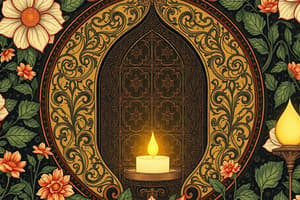Podcast
Questions and Answers
What are triglycerides composed of?
What are triglycerides composed of?
- Four fatty acids and a glycerol backbone
- Three fatty acids and a phosphate group
- One fatty acid and two glycerol molecules
- Three fatty acids and glycerol (correct)
Which type of oil typically contains only one double bond in its fatty acid chains?
Which type of oil typically contains only one double bond in its fatty acid chains?
- Highly unsaturated oils
- Polyunsaturated oils
- Saturated oils
- Monounsaturated oils (correct)
Which of the following oils is considered a drying oil?
Which of the following oils is considered a drying oil?
- Palm oil
- Soybean oil (correct)
- Coconut oil
- Safflower oil
What is a consequence of hydrogenation in oils?
What is a consequence of hydrogenation in oils?
Which type of cholesterol is increased by trans fatty acids?
Which type of cholesterol is increased by trans fatty acids?
Which configuration of double bonds causes a molecule to have a bend or kink?
Which configuration of double bonds causes a molecule to have a bend or kink?
What effect do omega-3 fatty acids from unsaturated plant oils have on human health?
What effect do omega-3 fatty acids from unsaturated plant oils have on human health?
What is the primary source of oil in olives?
What is the primary source of oil in olives?
How are unripe olives processed to make them edible?
How are unripe olives processed to make them edible?
Which type of olive oil is obtained from the first pressing of the best olives?
Which type of olive oil is obtained from the first pressing of the best olives?
What is the primary nutrient composition of sesame seeds?
What is the primary nutrient composition of sesame seeds?
What essential characteristic does the processing of cottonseed oil require?
What essential characteristic does the processing of cottonseed oil require?
Which acid is predominant in corn oil?
Which acid is predominant in corn oil?
What is a significant use of peanut oil?
What is a significant use of peanut oil?
What is a common product derived from sesame seeds?
What is a common product derived from sesame seeds?
Why is refined cottonseed oil not ideal for cooking?
Why is refined cottonseed oil not ideal for cooking?
What is the primary historical use of safflower?
What is the primary historical use of safflower?
In which region are peanuts primarily cultivated?
In which region are peanuts primarily cultivated?
What is the primary fatty acid content of soybean oil?
What is the primary fatty acid content of soybean oil?
What process is used to produce safflower oil?
What process is used to produce safflower oil?
What are the primary components of soap molecules that allow them to clean effectively?
What are the primary components of soap molecules that allow them to clean effectively?
Which plant oil is known to produce a significant amount of biodiesel and has an energy balance of 2.5 in Germany?
Which plant oil is known to produce a significant amount of biodiesel and has an energy balance of 2.5 in Germany?
What is a major drawback of biodiesel when produced from canola oils?
What is a major drawback of biodiesel when produced from canola oils?
What ancient civilization is known to have used soap-like substances for cleansing and medicinal purposes?
What ancient civilization is known to have used soap-like substances for cleansing and medicinal purposes?
Which fatty acid is primarily associated with the health benefits related to canola oil?
Which fatty acid is primarily associated with the health benefits related to canola oil?
What was the original form of soap as described in ancient Babylonian clay tablets?
What was the original form of soap as described in ancient Babylonian clay tablets?
What is the main purpose of adding lye in the traditional process of soap making?
What is the main purpose of adding lye in the traditional process of soap making?
Which plant oil is known for its high oil content and has been optimized for mechanical harvesting?
Which plant oil is known for its high oil content and has been optimized for mechanical harvesting?
Which feature distinguishes olive oil from other plant oils regarding its cultivation conditions?
Which feature distinguishes olive oil from other plant oils regarding its cultivation conditions?
What role does the high mucilage content of flax seeds play in health?
What role does the high mucilage content of flax seeds play in health?
Which group of individuals was responsible for producing the first modern soaps through saponification?
Which group of individuals was responsible for producing the first modern soaps through saponification?
Which property of sunflower oil makes it particularly valuable in cooking oils and processed foods?
Which property of sunflower oil makes it particularly valuable in cooking oils and processed foods?
What process is used to produce biodiesel from plant oils?
What process is used to produce biodiesel from plant oils?
What is the key characteristic of palm oil extracted from the mesocarp of the oil palm fruit?
What is the key characteristic of palm oil extracted from the mesocarp of the oil palm fruit?
Which variety of oil is derived exclusively from the seed of the oil palm?
Which variety of oil is derived exclusively from the seed of the oil palm?
What unique property does tung oil possess that makes it preferable for woodworkers?
What unique property does tung oil possess that makes it preferable for woodworkers?
How is coconut oil primarily extracted for commercial use?
How is coconut oil primarily extracted for commercial use?
What main ingredient characterizes carnauba wax?
What main ingredient characterizes carnauba wax?
Which of the following accurately describes the harvesting process of candelilla wax?
Which of the following accurately describes the harvesting process of candelilla wax?
What is a primary use of jojoba oil in modern industries?
What is a primary use of jojoba oil in modern industries?
What is a significant environmental concern related to palm oil monocultures?
What is a significant environmental concern related to palm oil monocultures?
Which type of fatty acid predominantly characterizes tung oil?
Which type of fatty acid predominantly characterizes tung oil?
What is a key characteristic of the fruit of the coconut palm?
What is a key characteristic of the fruit of the coconut palm?
Which statement is true about the yields of oil from the oil palm?
Which statement is true about the yields of oil from the oil palm?
What type of oil is used as a cocoa butter substitute?
What type of oil is used as a cocoa butter substitute?
Flashcards
Plant Oils
Plant Oils
Lipid-soluble triglycerides from plants, typically extracted from seeds or fruits.
Saturated Fats
Saturated Fats
Fats with no double bonds between carbon atoms in the fatty acid chain, fully saturated with hydrogen.
Unsaturated Fats
Unsaturated Fats
Fats with one or more double bonds between carbon atoms, not fully saturated with hydrogen.
Monounsaturated Oils
Monounsaturated Oils
Signup and view all the flashcards
Polyunsaturated Oils
Polyunsaturated Oils
Signup and view all the flashcards
Hydrogenation
Hydrogenation
Signup and view all the flashcards
Trans Fats
Trans Fats
Signup and view all the flashcards
Cis Fats
Cis Fats
Signup and view all the flashcards
Omega-3 Fatty Acids
Omega-3 Fatty Acids
Signup and view all the flashcards
Edible Oils
Edible Oils
Signup and view all the flashcards
Saponification
Saponification
Signup and view all the flashcards
Soap Ingredients
Soap Ingredients
Signup and view all the flashcards
Soap Composition
Soap Composition
Signup and view all the flashcards
Soap use history
Soap use history
Signup and view all the flashcards
Biodiesel Fuel Production
Biodiesel Fuel Production
Signup and view all the flashcards
Biodiesel vs. Petrodiesel
Biodiesel vs. Petrodiesel
Signup and view all the flashcards
Canola Oil Production
Canola Oil Production
Signup and view all the flashcards
Sunflower Oil Production
Sunflower Oil Production
Signup and view all the flashcards
Linseed/Flax Production
Linseed/Flax Production
Signup and view all the flashcards
Olive Oil Production
Olive Oil Production
Signup and view all the flashcards
Olive Oil Extraction
Olive Oil Extraction
Signup and view all the flashcards
Olive Types
Olive Types
Signup and view all the flashcards
Olive Processing
Olive Processing
Signup and view all the flashcards
Olive Oil Quality
Olive Oil Quality
Signup and view all the flashcards
Sesame Seed Uses
Sesame Seed Uses
Signup and view all the flashcards
Sesame Seed Culture
Sesame Seed Culture
Signup and view all the flashcards
Peanut Cultivation
Peanut Cultivation
Signup and view all the flashcards
Peanut Oil Use
Peanut Oil Use
Signup and view all the flashcards
Cottonseed Oil Production
Cottonseed Oil Production
Signup and view all the flashcards
Corn Oil Composition
Corn Oil Composition
Signup and view all the flashcards
Soybean Origin
Soybean Origin
Signup and view all the flashcards
Soybean Uses
Soybean Uses
Signup and view all the flashcards
Safflower Origin
Safflower Origin
Signup and view all the flashcards
Oil Palm
Oil Palm
Signup and view all the flashcards
Palm Oil
Palm Oil
Signup and view all the flashcards
Palm Kernel Oil
Palm Kernel Oil
Signup and view all the flashcards
Coconut
Coconut
Signup and view all the flashcards
Coconut Oil
Coconut Oil
Signup and view all the flashcards
Tung Oil
Tung Oil
Signup and view all the flashcards
Plant Waxes
Plant Waxes
Signup and view all the flashcards
Carnauba Wax
Carnauba Wax
Signup and view all the flashcards
Jojoba Wax
Jojoba Wax
Signup and view all the flashcards
Candelilla Wax
Candelilla Wax
Signup and view all the flashcards
Study Notes
Plant Oils
- Composition: Triglycerides made of three fatty acids and glycerol.
- Forms: Oils (liquid at room temp) and fats (solid at room temp).
- Source: Primarily seeds, sometimes fleshy fruits.
- Edible Examples: Olive, soybean, sunflower, safflower, coconut, and palm oils.
- Industrial Examples: "Drying oils" (cotton, soybean, castor bean, sunflower, safflower, linseed, tung) are used in lubricants, paints, and varnishes, and increasingly in biodiesel fuel.
Plant Oil Classifications
- Saturated Fats: No double bonds between carbon atoms, fully hydrogenated.
- Unsaturated Fats: One or more double bonds between carbon atoms, not fully hydrogenated.
- Monounsaturated Oils: One double bond.
- Polyunsaturated Oils: Multiple double bonds.
Hydrogenation and Trans Fats
- Hydrogenation: A process that saturates unsaturated fatty acids to increase stability (shelf life).
- Trans Fats: Created by hydrogenation, have a different molecular structure (trans double bonds).
- Cis Double Bonds: Hydrogen atoms on the same side of the double bond, often with a bend in the molecule.
- Trans Double Bonds: Hydrogen atoms on opposite sides of the double bond, more linear and stable. Increased melting points.
- Health Concerns: Trans fats raise "bad" LDL cholesterol and lower "good" HDL cholesterol; linked to increased heart disease risk.
- Natural Occurrence: Trans fats are rare in plant oils; mainly found in small amounts in ruminant meats and dairy.
Plant Oils and Human Health
- Essential Fatty Acids (EFAs): Unsaturated oils, especially omega-3s. Crucial for development, potentially reduce heart disease risk, and may alleviate depression/anxiety and prevent abnormal protein buildup in the brain.
Soap Manufacturing
- Saponification: Process of making soap from plant or animal oils reacting with a strong base (lye).
- Components: Fatty acids form salts with the base; glycerol is separated.
- Structure: Soap molecules have hydrophobic (grease-loving) and hydrophilic (water-loving) ends, allowing grease and dirt to be dissolved.
- History: Soap-like products used by Babylonians, Egyptians, Romans, and Muslims, with plant (e.g., olive) and animal forms.
- Modern Alternatives: Commercial detergents such as sodium laureth sulfate (SLES), and sodium lauryl sulfate (SLS) are less expensive, common alternatives to traditional oils-based soaps.
Biodiesel Fuel
- Composition: Methyl esters, different from petroleum diesel.
- Production: Transesterification converts plant oils into biodiesel using alcohol.
- Benefits: Reduced life-cycle emissions compared to petroleum diesel, renewable energy, potentially carbon-neutral.
- Drawbacks: Higher nitric oxide emissions, viscosity issues in cold temperatures, varying efficiency by species.
- Production Efficiency: Corn oil (150 kg/ha), Peanut/Sunflower oil (800-900 kg/ha), Canola oil (1000 kg/ha), Palm oil/Algae (over 5,000/7,000 kg/ha).
Major Plant Oils (Cool Temperate Climates)
- Canola: Versatile, high in healthy omega-3 and 6 fatty acids, widely used in foods and as a biodiesel source.
- Sunflower: Drought-tolerant, high-oil seeds, important cooking and processed foods.
- Linseed/Flax: Ancient crop, used both in edible oil (omega-3s and omega-6s, vitamin E, protein) and industrial products (linseed oil for paints, varnishes).
Major Plant Oils (Warm Temperate Climates)
- Olive: Rich source of monounsaturated fats (oleic acid), used in cooking and as the base for high-quality Virgin and Extra Virgin olive oils.
- Sesame: Ancient use, eaten whole or prepared as oils and pastes; high in unsaturated fatty acids, proteins, iron, and calcium.
- Peanut: Widely cultivated, source of cooking oil, peanut butter, and other products, high in unsaturated oil, protein, vitamins.
- Cottonseed: By-product of cotton industry; used in products like margarine, but less ideal for cooking due to solidifying at room temperature; contains polyunsaturated oils and vitamin E.
- Corn/Maize: Major agricultural crop, used globally for feedstock, oils, and food, mostly polyunsaturated fats (linoleic acid).
Major Plant Oils (Tropical Climates)
- Oil Palm: Very productive, but plantation practices have raised concerns about forest and biodiversity loss, high in saturated fats, useful in various foods, soaps, and cosmetics.
- Coconut: High in saturated fats, used in various foods and cosmetics, processed from dried copra.
- Tung: Source of drying oil used in paints, varnishes, and wood finishing, high in eleostearic acid (three double bonds).
Plant Waxes
- Composition: Complex lipids of long-chain alcohols and fatty acids.
- Function: Protective coating on leaves and fruits.
- Examples: Carnauba, jojoba, and candelilla waxes.
Studying That Suits You
Use AI to generate personalized quizzes and flashcards to suit your learning preferences.
Description
This quiz explores the composition, forms, and sources of plant oils, as well as their edible and industrial applications. It also covers the classifications of fats, including saturated and unsaturated fats, along with the processes of hydrogenation and the impact of trans fats.




